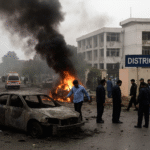Buner, Khyber Pakhtunkhwa (Pakistan) – Torrential monsoon rains and sudden cloudbursts have unleashed catastrophic flash floods in Buner, leaving widespread devastation. The death toll continues to rise, while residents brace for further rains and express frustration over slow relief services.
Death Toll Climbs in Buner
Authorities confirm that the death toll in Buner has surged past 270, with entire families wiped out in villages such as Beshonrai, Qadar Nagar, and Pir Baba. Rescue workers continue to recover bodies from collapsed homes and landslide debris, while dozens remain missing.
Nationwide, Pakistan has lost over 300 lives to monsoon flooding this season, but Buner remains the hardest-hit district.
More Rains on the Horizon
Meteorological experts warn of more heavy rainfall in the coming days, raising fears of fresh landslides and worsening floods. This year, the region has already received 50% more rainfall than average, intensifying the destructive impact of cloudbursts.
Relief Efforts Under Fire
Locals accuse authorities of failing to issue timely evacuation warnings, saying many remote villages never received alerts. While Army, paramilitary, and civilian rescue teams are on the ground, damaged roads, blocked valleys, and washed-out bridges have slowed aid deliveries.
A helicopter crash during a supply mission further hampered relief efforts, killing all five onboard. Despite these challenges, medical camps and heavy machinery are being deployed to speed up recovery operations.
Climate Change Behind Rising Disasters
Experts link the devastation in flood-hit Buner to climate change, pointing to erratic and more intense monsoon patterns across South Asia. Vulnerable mountain communities are increasingly at risk from flash floods and landslides triggered by extreme weather.
NDMA Alert: Rising River Levels and Intense Rainfall Expected
According to the latest convergence of meteorological models, there is a high probability of intense rainfall activity over the coming days. This weather pattern is likely to cause a significant rise in water levels across major river systems, including the Indus, Kabul, Swat, Chenab, Sutlej, and their tributaries.
Expected River Conditions
-
River Kabul (Nowshera): Projected to reach 100,000–140,000 cusecs, which may lead to a critical flooding situation.
-
River Indus (Kalabagh): Anticipated to rise to around 500,000 cusecs by 17th August, with medium to high flows of 375,000–500,000 cusecs expected at Chashma.
-
River Sutlej (Ganda Singh Wala): Likely to rise to 68,000–80,000 cusecs, causing low to medium flood conditions.
-
Upstream Chenab: Expected to reach approximately 150,000 cusecs between 17th–19th August.
Advisory and Safety Measures
Authorities have issued high alert warnings for the districts of Swat, Dir, Nowshera, Charsadda, Attock, Mianwali, D.I. Khan, and areas along the downstream Indus belt.
-
Communities living near riverbanks, nullahs, and bridges are strongly advised to avoid unnecessary travel.
-
Residents should stay updated through official alerts and follow the instructions of local authorities.
These developments highlight the need for heightened preparedness and close monitoring of vulnerable areas to minimize risks associated with potential flooding.
Conclusion
As the death toll in Buner rises, urgent action is needed to accelerate relief operations, strengthen disaster preparedness, and address the long-term challenge of climate resilience. With further rains predicted, the people of Buner remain caught between tragedy and uncertainty.









